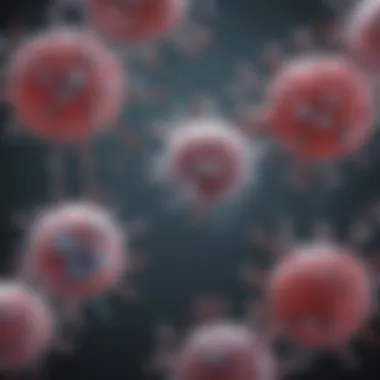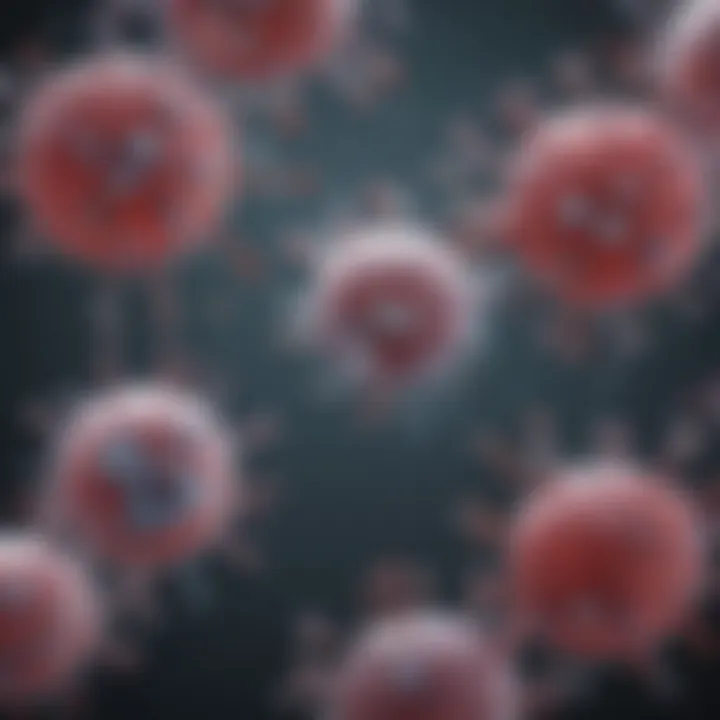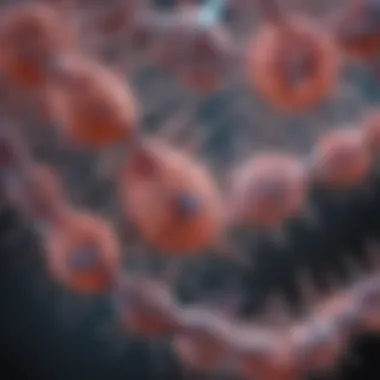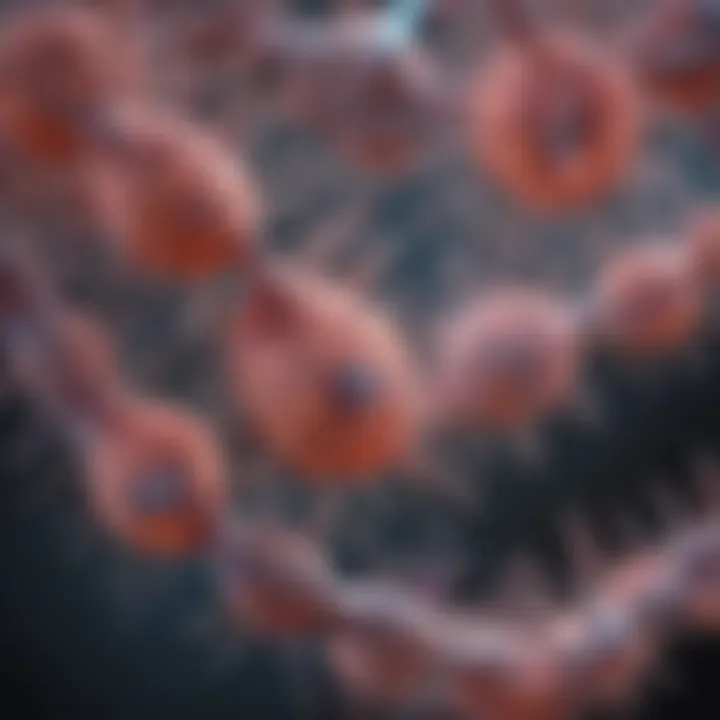Exploring Pro Caspase 3: Functions and Roles in Biology


Intro
Pro caspase 3 is an essential element in the intricate world of cellular biology, playing a pivotal role in the regulation of apoptosis. As a precursor to caspase 3, this molecule serves as no mere bystander; instead, it embodies a critical function in ensuring cellular health and homeostasis. Understanding pro caspase 3’s mechanisms and functions is crucial for both academic pursuits and practical applications in medical fields, especially considering its implications in diseases such as cancer.
This article aims to explore the complexities surrounding pro caspase 3 from its basic structure to its significant role in diseases, alongside highlighting recent research developments. With a focus on clarity, this guide provides valuable insights tailored for students, researchers, educators, and professionals interested in cellular biology and related disciplines.
Background and Context
Overview of the Research Topic
Pro caspase 3, an inactive precursor of the executioner caspase 3, is fundamentally involved in programmed cell death, a process vital for the development and maintenance of healthy tissues. When triggered by specific cellular signals, pro caspase 3 is activated through proteolytic cleavage, leading to the apoptosis pathway's initiation. This transformation marks a significant phase in various cellular responses, particularly in contexts where cellular integrity is compromised or inappropriate cell growth occurs.
Historical Significance
The understanding of pro caspase 3 has evolved significantly over the decades. Early research laid the groundwork for recognizing the role of caspases in apoptosis during the 1990s. These findings catalyzed further studies into pro caspases, uncovering their mechanisms and functions. Notably, research by L. Jänicke and colleagues established the importance of caspase activation in determining cell fate. This historical insight underscores how foundational studies continue to influence present-day research endeavors.
Key Findings and Discussion
Major Results of the Study
Recent investigations have illuminated several critical aspects of pro caspase 3. For instance, it has been established that the enzyme's activation is not solely dependent on proteolytic cleavage but also on the involvement of various regulatory proteins. These proteins can either promote or inhibit the activation of pro caspase 3, highlighting its regulation’s complexity. Moreover, an increasing body of evidence suggests that pro caspase 3 may also partake in non-apoptotic functions, particularly in cellular signaling pathways, challenging the traditional view of its role.
Detailed Analysis of Findings
- Activation Mechanisms:
- Non-Apoptotic Roles:
- Implications in Cancer Research:
- Activation often occurs via the binding of apoptotic signals, such as cytochrome c, leading to the formation of the apoptosome. This complex is crucial for the recruitment and activation of pro caspase 3.
- The involvement of initiator caspases, such as caspase 9, is a necessary step in this activation cascade, emphasizing the cooperative nature of apoptotic signaling.
- Recent studies have described pro caspase 3’s involvement in cellular processes such as differentiation and stress responses. These alternative pathways suggest the protein’s significance beyond merely executing cell death.
- The intricate connection with signaling cascades underscores the duality of pro caspase 3, serving both in managing cellular survival and orchestrating cell death.
- Given its regulatory functions, pro caspase 3 has gained attention in cancer studies. Its dysregulation can lead to abnormal cell proliferation and resistance to apoptosis, contributing to tumorigenesis.
- Understanding how to modulate pro caspase 3's activity presents potential therapeutic pathways that could enhance cancer treatment effectiveness.
In summary, pro caspase 3 plays an integral role in maintaining cellular balance. Its discovery is not only a historical milestone but also a continuing source of intrigue for modern biology. By synthesizing findings and exploring its implications in health and disease, we can appreciate the molecular intricacies that govern cellular dynamics.
Preface to Pro Caspase
Pro caspase 3 is a central player in the intricate web of cellular biology, particularly regarding programmed cell death. Understanding pro caspase 3 can provide insights into numerous biological processes. These include development, immune responses, and disease progression. This section will define pro caspase 3 and underline its significance in apoptosis, showcasing its dual roles in cell survival and death.
Defining Pro Caspase
Pro caspase 3 is the inactive precursor of caspase 3, an enzyme essential for executing apoptosis, a process where cells systematically dismantle themselves. Pro caspase 3, like other caspases, is synthesized as an inactive form to prevent premature activation. Its molecular weight is approximately 32 kDa, and it has a characteristic structure that includes several key domains, typically categorized as prodomains and active sites. Upon receiving specific apoptotic signals, pro caspase 3 undergoes proteolytic cleavage. This cleavage results in its activation, transforming it into an active caspase that can then execute the apoptotic program.
Importance in Apoptosis
The function of pro caspase 3 extends beyond mere activation into the fundamental aspects of apoptosis. Apoptosis is vital for maintaining cellular homeostasis, removing damaged or unnecessary cells. Importantly, pro caspase 3's role is pivotal in both intrinsic and extrinsic apoptotic pathways.
In the intrinsic pathway, signals from within the cell, like DNA damage, activate pro caspase 3 through a cascade involving various proteins such as cytochrome c. The extrinsic pathway, on the other hand, relies on external signals, primarily through death receptors on the cell surface. Here, pro caspase 3 is recruited to the death-inducing signaling complex.
The activation of pro caspase 3 is essential for the apoptotic process, ensuring that cellular death is executed efficiently and without damaging surrounding tissues.
Biophysical Properties of Pro Caspase
Understanding the biophysical properties of pro caspase 3 is vital in grasping its function and implications in cellular biology. This section analyzes its molecular structure and associated protein domains. These properties reveal how this precursor enzyme operates within different biological contexts.
Molecular Structure
Pro caspase 3 is composed of a specific arrangement of amino acids forming its unique structure. This structure is significant as it dictates how pro caspase 3 interacts with other molecules. The enzyme adopts an inactive form, which is crucial for regulating the process of apoptosis. Its structure includes an N-terminal pro-domain, a large subunit, and a small subunit. The pro-domain acts as a regulatory component, preventing unwanted activation. The large and small subunits are essential once the enzyme is activated, enabling its proteolytic function.
The structure has parallels with other caspases but features distinct characteristics that inform its specificity. The structural integrity of pro caspase 3 is influenced by ionic and hydrophobic interactions, which govern its stability and solubility in cellular environments. Furthermore, the presence of specific motifs and secondary structures such as alpha-helices and beta-sheets contributes to its overall function.
Protein Domains and Functions
The functions of pro caspase 3 are closely tied to its protein domains. The primary domain is responsible for its zinc-finger motif, which facilitates the interaction with substrates and inhibitors. This specific domain is crucial for the enzyme's ability to cleave vital proteins, thus playing a significant role in apoptosis.
There is also a catalytic domain that becomes active upon proteolytic cleavage. This feature indicates how pro caspase 3 functions in the effector phase of apoptosis. The activation is an intricate process that can be influenced by several regulatory proteins and pathways. The interplay between these domains is fundamental for achieving a balance between cell survival and programmed cell death.
In summary, the biophysical properties of pro caspase 3, including its molecular structure and protein domains, contribute decisively to its role in cellular processes. A clear understanding of these elements can lead to deeper insights into its mechanisms and implications in health and disease.
"Molecular understanding of pro caspase 3 can unlock pathways for novel therapeutic strategies."
In addition, ongoing research continues to unveil the complexities of its structure and function, highlighting the importance of these properties in the broader context of cellular biology.
Activation Mechanisms of Pro Caspase
The activation mechanisms of pro caspase 3 represent fundamental processes that regulate cellular apoptosis. Understanding these mechanisms is crucial within the context of this article, as they provide insight into how cells prevent excessive proliferation and promote orderly cell death. Dysregulation of these mechanisms can lead to various diseases, including cancer, making it vital to comprehend how pro caspase 3 is activated.
Caspase Activation Cascade
The caspase activation cascade is a series of molecular events essential for the activation of pro caspase 3 into its active form, caspase 3. This process typically begins with the cleavage of initiator caspases, such as caspase 8 and caspase 9. These initiator caspases respond to apoptotic signals and subsequently activate executioner caspases, primarily pro caspase 3. This hierarchy ensures that apoptosis is triggered only when required.
- Initiator Caspases: They are the first responders to apoptotic stimuli. Caspase 8, activated by death receptors, and caspase 9, activated by mitochondrial signals, engage in a feedback loop to perpetuate the cascade.
- Executioner Caspases: Pro caspase 3 is cleaved by the active initiator caspases to form the active enzyme, initiating the dismantling of cellular components necessary for apoptosis.
- Substrate Cleavage: The activated caspase 3 acts on specific substrates within the cell, leading to cellular morphology changes characteristic of apoptosis, such as chromatin condensation and membrane blebbing.
Through this cascade, the cell ensures that pro caspase 3 only becomes active in the appropriate cellular context, safeguarding against unintended cell death.
Role of Other Proteins
Activation of pro caspase 3 does not occur in isolation. Various other proteins play a vital role in its activation and regulation. These proteins can modulate the caspase activation cascade in different ways:


- Adaptor Proteins: Proteins such as FADD (Fas-associated protein with death domain) and Apaf-1 (apoptotic protease-activating factor 1) assist in recruiting and activating caspases at different signaling sites. This recruitment ensures that pro caspase 3 activation occurs efficiently and effectively.
- Inhibitors of Apoptosis (IAPs): IAPs such as XIAP bind to caspases and can inhibit their activity, providing a counterbalance to the activation. This regulation is essential to prevent excessive apoptosis and control cell fate.
- Pro-apoptotic and Anti-apoptotic Factors: Proteins like Bax and Bcl-2 respectively promote and inhibit apoptosis. Their competitive interactions influence the activation of pro caspase 3, emphasizing the complexity of apoptotic regulation.
Understanding these proteins' roles is essential to deciphering the intricacies of apoptotic signaling and may offer insights into potential therapeutic targets for conditions linked to caspase dysregulation.
"Caspase activation is a tightly regulated process to maintain cellular homeostasis. The interplay between pro-apoptotic and anti-apoptotic factors illustrates the balance required for cell survival."
This cohesive interaction between proteins and caspases underscores the importance of the activation mechanisms of pro caspase 3 as a critical area of interest in cellular biology.
Functional Roles in Cellular Processes
Understanding the functional roles of pro caspase 3 is crucial in the broader context of cellular biology. This protein is not merely a participant in apoptosis but also influences various pathways essential for cellular health and stability. The implications of these roles extend to development, disease states, and overall cellular dynamics. Exploring how pro caspase 3 affects cellular processes deepens the comprehension of both normal physiological functions and pathological conditions.
Involvement in Apoptotic Pathways
Pro caspase 3 is prominently recognized for its substantial involvement in apoptotic pathways. Apoptosis serves as a critical mechanism through which cells undergo programmed cell death, thus maintaining homeostasis within tissues. When cells are exposed to stress or damage, such as DNA fragmentation or oxidative insult, pro caspase 3 gets activated via cleavage into active caspase 3. This activation marks the beginning of a cascade of events leading to cellular dismantling and removal without inciting inflammation.
The significance of pro caspase 3 in the execution phase of apoptosis cannot be understated. It orchestrates the breakdown of cellular components, allowing for an orderly cell death process. By facilitating this process, pro caspase 3 prevents the accumulation of potentially harmful cells, which might otherwise lead to tumorigenesis or adverse reactions in neighboring cells. Notably, its role is not isolated; it intertwines with various other factors and pathways, offering a level of sophistication in cellular response mechanisms.
Influence on Cell Proliferation
In addition to its apoptosis-related functions, pro caspase 3 plays a significant role in influencing cell proliferation. While predominantly viewed as a mediator of cell death, recent findings indicate that it also participates in signaling pathways that can promote cell cycle progression. The complexity of pro caspase 3's actions adds layers of understanding to how cells balance survival and cell death decisions.
Research has shown that pro caspase 3 may interact with various cellular signaling pathways that regulate proliferation. For instance, it can modulate signals related to growth factors, hence playing a role in promoting cellular proliferation under certain contexts. Conversely, when apoptosis is favored, pro caspase 3's activation leads to cell cycle arrest, essentially halting division to allow the apoptotic process to unfold.
"The multifunctionality of pro caspase 3 highlights its essential roles in both promoting cell death and regulating cell growth, underlining the critical balance cells must achieve in response to differing stimuli."
In summary, pro caspase 3's involvement in both apoptotic pathways and its influence on cell proliferation underscores its critical significance in cellular homeostasis. Understanding these processes provides essential insights into how disturbances in pro caspase 3 activity can culminate in pathological conditions, particularly in cancer. This knowledge serves as a pathway for researchers and clinicians to explore new therapeutic avenues.
Pro Caspase and Cancer Biology
Pro caspase 3 plays a critical role in cancer biology due to its involvement in apoptosis and cellular signaling pathways. Understanding pro caspase 3's functions can provide insights into how its dysregulation contributes to tumorigenesis and cancer progression. This section discusses its specific roles in these processes and its potential as a therapeutic target.
Role in Tumorigenesis
Pro caspase 3 is often referred to as the executioner of apoptosis. When activated, it cleaves various substrates that lead to cellular death. However, in cancer, the regulation of apoptosis is frequently disrupted.
- Dysregulation in Cancer: In many tumors, pro caspase 3 expression is altered. High levels can result in enhanced sensitivity to apoptotic signals, while low levels may help tumor cells evade death. This balancing act determines the cell's fate during cancer progression.
- Cell Cycle Influence: Pro caspase 3 intersects with other cellular pathways beyond apoptosis. It may influence the cell cycle, affecting proliferation directly. This adds another layer to its role in tumorigenesis, where abnormalities can lead to an unchecked increase in cell numbers.
- Interactions with Oncogenes and Tumor Suppressors: The interplay between pro caspase 3 and various oncogenes or tumor suppressors can significantly impact tumor behavior. For instance, mutations in p53 may lead to diminished pro-caspase 3 activity, promoting cell survival and tumor growth.
Therapeutic Implications
The therapeutic landscape involving pro caspase 3 is increasingly complex. Its potential as a target for cancer therapies is notable due to two main aspects.
- Targeting Signaling Pathways: Therapies that enhance the activity of pro caspase 3 or mimic its activation could promote apoptosis in resistant cancer cells. This may be central to treatments aimed at restoring normal apoptotic processes in cancers where these pathways are impaired.
- Inhibitor Development: On the flip side, understanding how to inhibit pro caspase 3 could be beneficial in scenarios where excessive apoptosis leads to tissue damage, such as in specific cancers or during chemotherapy. Targeted therapies could help manage this delicate balance.
"Pro caspase 3 serves as a double-edged sword in cancer biology—its regulation impacts both cell survival and cancer progression."
The challenges of targeting pro caspase 3 in clinical settings are significant. Effectiveness, specificity, and the potential for side effects must be carefully assessed. Research into small molecules and biologics that influence its activity continues to evolve, presenting opportunities for innovative cancer treatment strategies.
Regulatory Mechanisms Influencing Pro Caspase
Understanding the regulatory mechanisms that influence pro caspase 3 is essential for a holistic view of its role in cellular processes. Pro caspase 3 functions both as a precursor to its active form and as a pivotal player in apoptosis. Its regulation is crucial because it can determine whether a cell undergoes programmed death or survives. Factors such as post-translational modifications and feedback mechanisms contribute significantly to the activity and stability of pro caspase 3.
Post-Translational Modifications
Post-translational modifications play a critical role in dictating the activity of pro caspase 3. These modifications include phosphorylation, ubiquitination, and acetylation, among others. Each of these changes can alter the conformation of the protein, which in turn affects its interaction with other molecules. For example, phosphorylation typically enhances or diminishes enzymatic activity, depending on the sites involved. Ubiquitination, on the other hand, often marks proteins for degradation, effectively removing pro caspase 3 from the cellular landscape.
Key points about post-translational modifications:
- Phosphorylation: Can enhance pro caspase stability or trigger its activation.
- Ubiquitination: Often leads to proteasomal degradation of the protein.
- Acetylation: This may modulate its interactions with other proteins, influencing apoptotic pathways.
These modifications can be context-dependent, meaning their effects may vary according to the cellular environment. The ability to fine-tune pro caspase 3 through such mechanisms reflects the complexity of cellular regulation.
Feedback Mechanisms
Feedback mechanisms are integral to maintaining the balance between cell survival and death. In the case of pro caspase 3, certain pathways can provide negative or positive feedback. For instance, the activation of caspases might lead to the increased expression of inhibitors such as caspase-activated DNase, which in turn can keep pro caspase 3 in check, preventing excessive apoptosis.
Additionally, some cellular pathways produce factors that can inhibit or promote the activity of pro caspase 3. These regulatory influences are essential because they can prevent unwanted cell death and ensure that apoptosis occurs in a regulated manner. Feedback mechanisms can involve complex interactions with other proteins or even signaling pathways outside the apoptotic context.
"The regulation of pro caspase 3 showcases the intricate balance that governs cellular fate, presenting a delicate interplay of molecular signals."
Key points about feedback mechanisms:
- Positive Feedback: Activation of apoptotic pathways can enhance pro caspase activation, pushing cells towards death.
- Negative Feedback: Inhibitors such as XIAP or FLIP can prevent caspase activation, promoting cell survival.
Interplay with other Caspases
Pro caspase 3 does not act alone in the intricate network of cellular apoptosis. Its interactions with other caspases, particularly caspase 2 and caspase 8, are essential for understanding its role in programmed cell death and cellular signaling. These caspases not only influence pro caspase 3 activation but also modulate its functions in various cellular contexts. Hence, a thorough examination of these interactions reveals the complexity of apoptosis regulation and the critical balance required for maintaining cellular homeostasis.
Caspase and Interactions
Caspase 2 and caspase 8 are integral components of the apoptotic machinery that interfaces directly with pro caspase 3. Caspase 2 is often considered a stress-activated caspase that can initiate apoptosis under conditions that may not involve a clear damage signal. Upon activation, caspase 2 can cleave pro caspase 3, leading to its mature form and subsequent execution of apoptotic pathways. This pathway highlights caspase 2's role as an initiator in the apoptotic process.
Caspase 8, on the other hand, is a pivotal component of the extrinsic apoptotic pathway, primarily activated by death receptors on the cell surface. When activated, caspase 8 can also directly cleave and activate pro caspase 3. The interplay between these two caspases demonstrates a tiered regulation of apoptosis, where specific signaling avenues can lead to pro caspase 3 activation depending on the cellular context. This interaction reflects both redundancy and specificity in the apoptotic signaling networks, ensuring that cells can respond efficiently to various apoptotic cues.
Functional Redundance and Divergence
The interplay among pro caspase 3, caspase 2, and caspase 8 illustrates both functional redundancy and divergence.
- Redundancy: Multiple pathways leading to the activation of pro caspase 3 can prevent single points of failure. If one pathway is compromised, others can compensate. This aspect provides robustness to apoptosis, which is critical for normal cellular function.
- Divergence: Different caspases can influence distinct cellular outcomes based on the tissues or pathological conditions involved. For example, caspase 8 may mediate apoptosis in certain embryonic development stages, while caspase 2 may deal with cellular stress responses. This divergence in function highlights how specific conditions prompt unique apoptotic pathways. The regulation of pro caspase 3 is thus nuanced, allowing for flexibility and precision in cellular responses.


Understanding the interplay between pro caspase 3 and other caspases is crucial for deciphering the complex landscape of apoptosis regulation.
Implications in Neurodegenerative Diseases
Pro caspase 3 holds significant relevance in the study of neurodegenerative diseases. This is primarily due to its pivotal role in apoptosis, a process that, when dysregulated, may contribute to various neurodegenerative pathologies. Understanding the implications of pro caspase 3 in this context can help researchers illuminate the mechanisms underlying these diseases and potentially direct therapeutic interventions.
Contribution to Neurodegeneration
The involvement of pro caspase 3 in neurodegenerative processes can be observed in diseases such as Alzheimer’s, Parkinson’s, and Huntington’s disease. Elevated levels of pro caspase 3 have been noted in the brains of individuals affected by these conditions. Its activation can lead to widespread apoptosis of neurons, which is detrimental to maintaining neural integrity.
In Alzheimer's disease, for instance, the accumulation of amyloid-beta and tau proteins can trigger apoptotic cascades mediated by pro caspase and result in neuronal death. Such rresearch shows that disruption in the balance between survival and death signaling is a hallmark of neurodegeneration. When apoptosis is excessively activated, it fuels the progression of these diseases.
Potential as a Therapeutic Target
The inherent role of pro caspase 3 in neuronal apoptosis presents opportunities for therapeutic targeting. By developing inhibitors that can specifically modulate its activity, researchers can aim to prevent unwanted neuronal loss. Therapeutics designed to downregulate the activity of pro caspase 3 may relieve symptoms or slow the progression of neurodegenerative diseases.
On the other hand, enhancing pro caspase 3 activity may also have situational benefits, such as in the case of certain brain tumors where apoptosis may need to be induced in aberrant cells.
Therefore, the direction of future research must focus not only on understanding the mechanics of pro caspase 3's role in neurodegeneration but also on developing drugs that can fine-tune its activity, offering new hope in treating these complex diseases.
Overall, the implications of pro caspase 3 in neurodegenerative diseases underscore its dual role as both a contributor to neural cell death and a potential therapeutic target. The fine balance between its pro-survival and pro-death actions will be critical in devising effective treatments.
Pro Caspase in Developmental Biology
Pro caspase 3 plays an important role in developmental biology. It is essential in regulating cell death and survival during crucial stages of development. This section will elaborate on two significant areas: the role of pro caspase 3 in embryogenesis and its impact on organogenesis.
Role in Embryogenesis
During embryogenesis, the process by which an embryo forms and develops, pro caspase 3 is fundamental for various reasons. Initially, it ensures the proper elimination of unnecessary cells. This is vital for shaping the developing organism. Apoptosis, mediated by caspases, including pro caspase 3, contributes significantly to morphogenetic processes.
For example, pro caspase 3 encourages the removal of cells that are no longer needed. These can include excess cells in specific tissues or cells that have reached the end of their life cycle. The regulation of this process is critical for normal development. If apoptotic pathways are disrupted, it may lead to various developmental disorders.
Impact on Organogenesis
Organogenesis, the formation of organs, is another area where pro caspase 3 exerts its influence. During this phase, precise timing and control of cell proliferation and apoptosis are essential. Pro caspase 3 ensures that the right number of cells are present in developing organs. It balances the signals for growth and death, which is needed for healthy organ formation.
Understanding the regulatory functions of pro caspase 3 in organogenesis can lead to insights into congenital anomalies.
Disruptions in the regulation of pro caspase 3 can result in an excess of cells or insufficient cell numbers, which may lead directly to organ malformations. Notably, this highlights the importance of studying pro caspase 3 not only for understanding normal development but also for addressing developmental pathologies.
In summary, pro caspase 3 is critical in embryogenesis and organogenesis. Its regulatory functions shape various stages of development, ensuring that cellular processes occur smoothly. Understanding these mechanisms holds significant implications for developmental biology as a whole.
Research Advances and Future Directions
New research into pro caspase 3 has opened avenues for understanding its role beyond apoptosis. The study of this precursor molecule is crucial for comprehending wider cellular mechanisms. Current research not only focuses on its biochemical properties but also explores its relevance in various diseases, including cancer and neurodegeneration. As our knowledge deepens, the integration of findings across different fields may lead to innovative therapeutic approaches.
Current Research Trends
Recent studies highlight several important trends in the examination of pro caspase 3.
- Focus on Non-Apoptotic Functions: Researchers are now identifying roles of pro caspase 3 in cellular proliferation and other signaling pathways.
- Disease Associations: Growing evidence shows links between dysregulation of pro caspase 3 and conditions like cancer and Alzheimer’s disease. Its study is becoming more focused on understanding how alterations affect disease progression.
- Targeted Therapeutics: There is an increasing interest in developing specific inhibitors or modulators that target pro caspase 3 for potential therapeutic benefits, indicating a shift towards precision medicine.
As such trends develop, research priorities adapt to uncover the full potential of targeting pro caspase 3 in various contexts.
Emerging Technologies in Study
Technological advancement has significantly influenced the research landscape around pro caspase 3.
- CRISPR-Cas9 Gene Editing: This technology allows for precise modifications in pro caspase 3 genes, aiding in studying functional implications of its alterations.
- Proteomics: Advanced proteomic techniques are enabling researchers to identify interacting partners of pro caspase 3, revealing complex cellular networks.
- High-Throughput Screening: Efficient methods to screen for small molecules can expedite the discovery of potential inhibitors affecting pro caspase 3 activity.
New technologies are redefining how we investigate pro caspase 3, making comprehensive studies more feasible and insightful.
Each of these innovations holds promise in elucidating the multifaceted roles of pro caspase 3, ultimately leading to improved diagnostic and therapeutic strategies.
Comparative Analysis Across Species
The study of pro caspase 3 and its functions often requires a comparative approach across different species. This analysis provides insights into evolutionary adaptations and functional roles of pro caspase 3 in various contexts. By examining similarities and differences in pro caspase 3 molecules from diverse organisms, researchers can identify conserved mechanisms and species-specific adaptations. This understanding is vital, especially given the role of pro caspase 3 in critical processes like apoptosis and cellular signaling.
Key Aspects of Comparative Analysis:
- Identification of Conserved Regions: Understanding which parts of the pro caspase 3 protein are conserved across species can indicate their essential roles in cellular processes.
- Evolutionary Insights: Insights into how pro caspase 3 has evolved over time in different organisms can shed light on the emergence of complex apoptotic pathways.
- Biological Relevance: Each species might display unique pathways involving pro caspase 3, influencing how scientists interpret its role in disease states such as cancer.
This comparative aspect is essential for contextualizing research findings that emerge from singular species studies. It informs drug development and therapeutic strategies by pinpointing conserved mechanisms that may be targeted across species, enhancing the translational potential of research findings.
Evolutionary Perspective
Understanding pro caspase 3 evolution across species allows for a better grasp of its biological significance. In many organisms, the conservation of pro caspase 3 suggests that the roles it plays are crucial for survival. Phylogenetic studies reveal that pro caspase 3 has remained relatively unchanged in many higher organisms, suggesting its foundational importance in managing cellular fate. For instance, comparisons between humans and mice highlight similarities that inform mouse models used in research.
This evolutionary perspective can also raise questions about the functional divergence in species like invertebrates versus vertebrates, leading to the hypothesis that while the core functions may be conserved, there are specific adaptations that serve varied ecological niches.
Functional Conservation and Divergence
Pro caspase 3 illustrates both conservation and divergence across species. On the one hand, its primary role in apoptosis is widely conserved, underlining its importance in cellular homeostasis. Models in humans, mice, and even simpler organisms like yeast show similar pathways activating pro caspase 3, reinforcing its significance in programmed cell death.
However, functional divergence also exists. In many invertebrates, the regulatory mechanisms involving pro caspase 3 differ, which may reflect distinct evolutionary pressures. For instance, certain invertebrates exhibit less reliance on apoptosis for development and survival, leading to variations in the functional expression of caspases. Such differences are critical in tailoring research approaches. They guide the choice of model organisms in studies aimed at understanding specific diseases or developing treatments. Many therapeutic approaches derived from mammalian studies may not translate effectively to other species without consideration of these divergences.
"Understanding evolutionary dynamics of pro caspase 3 across species enhances our knowledge of its cellular roles and implications in health and disease."
In summary, the comparative analysis of pro caspase 3 across species contributes significantly to our understanding of its biological roles and therapeutic potentials. It combines evolutionary context with practical considerations essential for cellular biology research.


Understanding Inhibitors of Pro Caspase
Exploring inhibitors of pro caspase 3 is critical for a comprehensive understanding of apoptosis and related cellular processes. Pro caspase 3 itself is a key player in programmed cell death, and its regulation can significantly affect not just cell survival but also overall organism health. Abnormalities in apoptosis are often linked to various pathologies, including cancer, neurodegeneration, and autoimmune diseases. As such, knowing how to modulate pro caspase 3 through its inhibitors opens up potential avenues for therapeutic strategies.
Identifying specific inhibitory proteins that affect pro caspase 3 enhances our grasp of its role in biological systems. Furthermore, therapeutic development focused on these inhibitors can yield significant benefits in clinical settings, providing potential treatments for conditions where apoptosis needs to be precisely controlled.
Identification of Inhibitory Proteins
The identification of proteins that inhibit pro caspase 3 is pivotal. Various proteins, such as inhibitor of apoptosis proteins (IAPs), have been shown to directly interfere with the activation of caspases, including pro caspase 3. These IAPs bind to caspases and promote their degradation, thus preventing apoptosis.
Some well-studied proteins include:
- XIAP (X-linked inhibitor of apoptosis protein): binds to activated caspase 3, thereby inhibiting its function.
- cIAPs (cellular IAPs): regulate both caspase activity and the NF-kB signaling pathway, affecting inflammatory responses.
Understanding the mechanisms of these inhibitors helps to shed light on how apoptosis is fine-tuned within cells. The regulation can vary in different cellular contexts, which is essential when considering therapeutic interventions.
Therapeutic Development of Inhibitors
The development of inhibitors targeting pro caspase 3 has tremendous therapeutic implications. In cancers, where apoptosis is often disrupted, restoring the normal apoptotic process can be beneficial. This involves either inhibiting the inhibitors (such as IAPs) or developing small molecules that mimic the action of natural pro-apoptotic factors.
Current research includes:
- Small-molecule inhibitors: These are being developed to modulate the activity of IAPs, providing a method to restore apoptosis in cancer cells.
- Gene therapy approaches: Introducing genes that encode pro-apoptotic proteins can counteract the inhibition by IAPs and promote cancer cell death.
Understanding and manipulating these inhibitory proteins not only aids in cancer therapies but also enhances our ability to confront other diseases where cell death regulation is disrupted. As research progresses, we can anticipate more innovative strategies to harness these inhibitors in clinical practice.
The regulation of pro caspase 3 through its inhibitors represents a critical frontier in both cellular biology and therapeutic innovation.
Pro Caspase in Cell Survival and Death
Understanding pro caspase 3 is pivotal in the study of cellular biology. This precursor serves as a regulatory point in the delicate balance of cell survival and death. It is essential in apoptosis, the programmed cell death that eliminates unnecessary or damaged cells. Apoptosis is not merely a pathway for eliminating cells; it maintains cellular health and homeostasis. The role of pro caspase 3 extends beyond being a mere precursor to caspase 3; it has intricate ties to various survival signals that ensure cellular identity and function.
Balance of Pro Survival and Pro Death Signals
The signaling pathways associated with pro caspase 3 revolve around its ability to integrate pro-survival and pro-death signals. Under normal conditions, pro-caspase 3 activity is tightly regulated. It can be influenced by several external signals generated through receptors, such as those in the TNF pathway. These signals dictate whether a cell undergoes apoptosis or survives.
When pro-survival signals dominate, cells remain viable and functional. For example, growth factors can activate pathways like the PI3K/Akt pathway, which interrupts the apoptotic process. Conversely, when pro-death signals prevail, pro-caspase 3 gets activated, leading to apoptosis. This intersection shows how cells can make decisions based on their environment.
"Caspases are not only critical for executing apoptosis, but they also influence other cellular processes that can lead to survival or death."
Key elements influencing this balance include:
- Cellular stress factors: These can include oxidative stress or nutrient deprivation, signaling the need for apoptosis.
- Cytokines: Molecules like TNF can promote cell death in the presence of specific conditions.
Context-Dependent Functional Outcomes
Pro caspase 3's role in cellular outcomes is not static; it varies depending on context. In different cellular environments, the outcome of pro caspase 3 activation can lead to vastly different results. For instance, in a healthy tissue homeostasis scenario, activation of pro caspase 3 aligns with controlled apoptosis. However, in pathological conditions like cancer, pro caspase 3 may behave in unexpected ways.
In tumors, it is common to find alterations in the apoptotic machinery. In certain cancer types, pro caspase 3 levels may be suppressed or dysregulated, allowing cells that should undergo apoptosis to survive. On the other hand, some treatments aim to exploit pro caspase 3 to trigger apoptosis in tumor cells. Hence, understanding its context-dependent behavior becomes crucial for therapeutic advancements.
The outcomes associated with pro caspase 3 can be categorized as follows:
- Pro-apoptotic triggers in normal cells.
- Resistance mechanisms in cancer cells.
- Dual roles in various signaling pathways.
In summary, pro caspase 3 plays a crucial role in determining cell fate. By balancing pro-survival and pro-death signals, it sets in motion a cascade that can lead to cell survival or death. Grasping these dynamics is essential for developing therapeutic strategies targeting apoptosis-related pathways.
Ethical Considerations in Pro Caspase Research
Research on pro caspase 3 and its role in apoptosis involves various ethical considerations. Understanding the implications of this research is essential for guiding the development of therapies and interventions that may arise from these studies. In an era where the boundaries of science and ethics often intertwine, it is crucial to consider how pro caspase 3 research can impact human health, especially in regenerative medicine and cancer therapies.
Implications for Human Health Research
The exploration of pro caspase 3 has significant implications for human health. Research findings can lead to more targeted cancer therapies, aiming to enhance apoptosis selectively in cancerous cells without affecting normal tissues. This understanding can also play a role in developing treatments for neurodegenerative diseases, where the regulation of cell death is disrupted.
However, the translation of basic science into clinical practice must be approached with caution. Ethical implications include issues surrounding informed consent from patients, especially when trials involve genetic manipulation or stem cell research linked to apoptosis pathways. It is also important to consider disparities in access to such therapies once they are developed.
Studies must undergo rigorous ethical review processes, ensuring that they prioritize well-being and dignity of human subjects.
Oversight in Pharmaceutical Research
The development of pro caspase 3 inhibitors as therapeutic agents necessitates careful oversight. Regulatory bodies must ensure that research complies with ethical standards and guidelines. This oversight involves assessing study designs, safety protocols, and the potential risks and benefits of new drugs targeting this pathway.
Pharmaceutical companies are often driven by profit motives, which can lead to conflicts of interest that threaten public trust. Implementation of transparent practices can mitigate these issues.
Moreover, as we learn more about pro caspase 3, researchers must continue to evaluate the broader social implications, including how these therapies can be distributed equitably among different populations. Ensuring that marginalized groups are not excluded from research benefits is vital for ethical integrity in this field.
Ethical considerations in pro caspase research serve not only to guide scientific integrity but protect human rights and ensure fairness in therapeutic advancements.
Culmination
The conclusion serves as a vital component in any academic discourse, particularly in articulate topics like pro caspase 3's role in cellular biology. It encapsulates critical content reviewed throughout the article, emphasizing the relevance of findings presented. In terms of pro caspase 3, the summation is not merely about repeating facts but synthesizing key insights that underline its biological significance and therapeutic potential.
Summation of Findings
In revisiting pro caspase 3's multifaceted functions, we must highlight its essential role in apoptosis and cellular signaling. Pro caspase 3, while being a precursor, is not just a passive entity; it orchestrates pathways that contribute to cellular homeostasis. Its interactions with various regulatory proteins and other caspases reveal enhanced complexity in apoptotic signaling. The implications of these findings extend to understanding tumorigenesis and neurodegenerative diseases, opening avenues for pharmacological interventions.
A few crucial points include:
- Pro caspase 3 activation is a stepwise cascade, pivotal in programmed cell death.
- Its regulatory mechanisms, such as post-translational modifications, influence its functional outcomes in cells.
- Understanding its role in diseases positions pro caspase 3 as a potential target for therapeutic interventions.
Future Research Directions
Looking ahead, future research on pro caspase 3 could take multiple trajectories. Areas that warrant deeper exploration include:
- Further elucidation of its interactions with other caspases: It remains crucial to clarify how pro caspase 3 interacts within different cellular contexts. Research could target its role alongside caspase 2 and caspase 8 to understand better the redundancy in apoptosis pathways.
- In-depth studies on its inhibitors: Identifying and characterizing specific inhibitory proteins could lead to novel approaches in cancer treatment, as well as in neurodegenerative conditions.
- Use of advanced technologies: Employing CRISPR and proteomics could unravel new dimensions of pro caspase 3 functions, potentially revealing its involvement in broader cellular processes.







